The AMD A8-7670K APU Review: Aiming for Rocket League
by Ian Cutress on November 18, 2015 8:00 AM ESTOffice Performance
The dynamics of CPU Turbo modes, both Intel and AMD, can cause concern in environments with variably-threaded workloads. There is also an added issue of the motherboard remaining consistent, depending on how the motherboard manufacturer wants to add in their own boosting technologies over the ones that Intel would prefer they used. In order to remain consistent, we implement an OS-level unique high-performance mode on all the CPUs we test, which should override any motherboard manufacturer performance mode.
All of our benchmark results can also be found in our benchmark engine, Bench.
Dolphin Benchmark: link
Many emulators are often bound by single-thread CPU performance, and general reports tended to suggest that Haswell provided a significant boost to emulator performance. This benchmark runs a Wii program that ray traces a complex 3D scene inside the Dolphin Wii emulator. Performance on this benchmark is a good proxy of the speed of Dolphin CPU emulation, which is an intensive single-core task using most aspects of a CPU. Results are given in minutes, where the Wii itself scores 17.53 minutes.
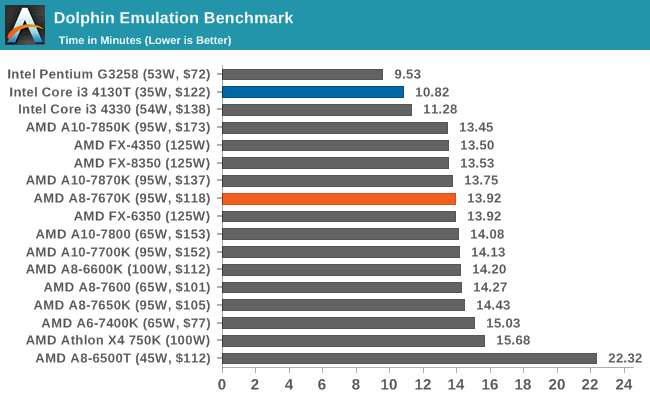
All AMD CPUs performed similarly here.
WinRAR 5.0.1: link
Our WinRAR test from 2013 is updated to the latest version of WinRAR at the start of 2014. We compress a set of 2,867 files across 320 folders totaling 1.52GB – 95% of these files are small typical website files, and the rest (90% of the size) are small 30-second 720p videos.
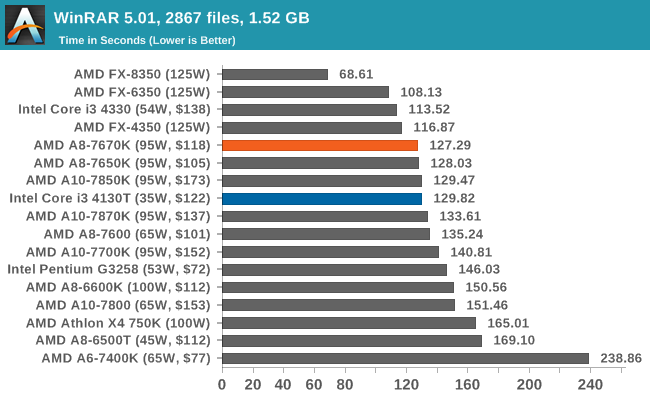
WinRAR is all about threads and DRAM speed, so the CPUs that can support higher DRAM frequencies get a boost.
3D Particle Movement
3DPM is a self-penned benchmark, taking basic 3D movement algorithms used in Brownian motion simulations and testing them for speed. High floating point performance, MHz and IPC win in the single-thread version, whereas the multithread version has to handle the threads, and loves more cores.
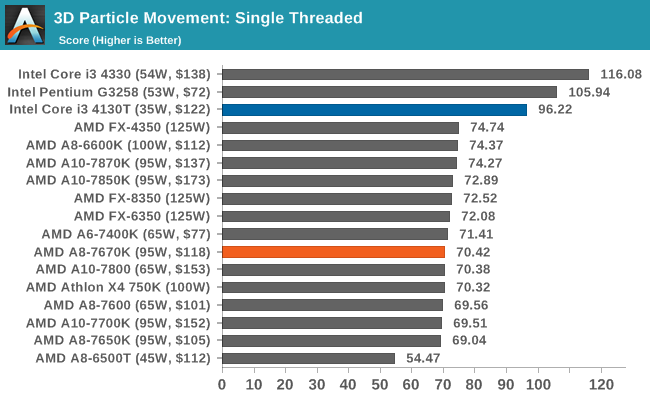
Again, all AMD CPUs seem to perform similarly in 3DPM for single-thread mode, indicating that something more fundamental about the design is a bottleneck.
FastStone Image Viewer 4.9
FastStone is the program I use to perform quick or bulk actions on images, such as resizing, adjusting for color and cropping. In our test, we take a series of 170 images in various sizes and formats, and convert them all into 640x480 .gif files, maintaining the aspect ratio. FastStone does not use multithreading for this test, and results are given in seconds.
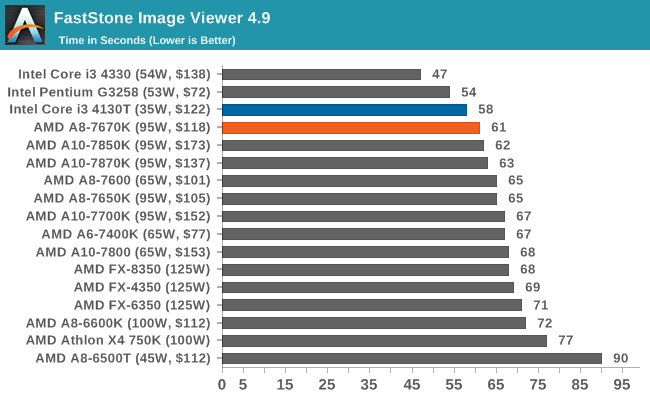
Single-thread frequency and IPC win here.
Web Benchmarks
On the lower-end processors, general usability is a big factor of experience, especially as we move into the HTML5 era of Web browsing. For our Web benchmarks, we take four well-known tests with Chrome 35 as a consistent browser.
Mozilla Kraken 1.1
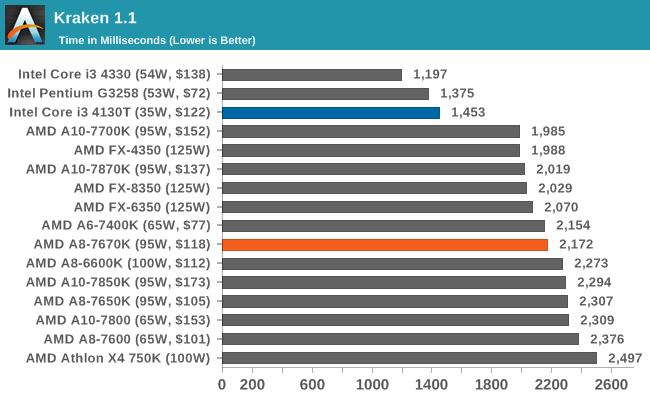
WebXPRT
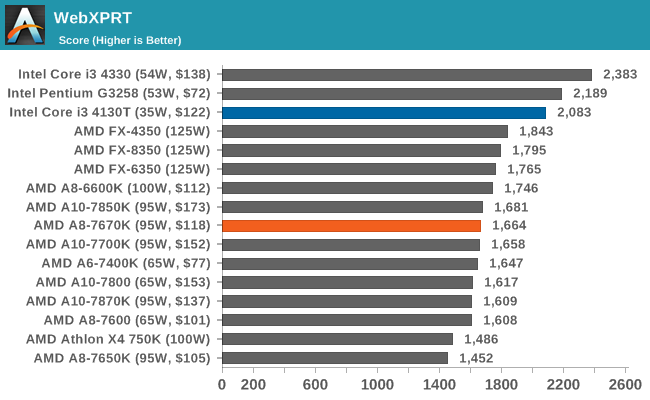
Google Octane v2











154 Comments
View All Comments
Drumsticks - Wednesday, November 18, 2015 - link
If AMD really could get a 40% single threaded performance boost on their CPUs for Zen, and they can do it no later than Kaby Lake, then they really might get a moment to breath. That puts single threaded performance right around Intel's i3 parts, and would put multi-threaded performance (and likely graphics although that's a different story) well ahead. It's not going to take back the desktop market overnight, but it would be enough to get PC builders and maybe some OEMs interested and get enough volume moving for them to survive.Even if we budget a 10% IPC boost for Intel in Kaby Lake, that puts their i3's barely ahead, and still probably significantly behind in multi threaded performance compared to a 4 core Zen part. Here's hoping for an AMD recovery! I'd love to recommend AMD parts in more than just the $300 region now. Even if Zen only gets a single OEM to genuinely notice AMD, it will be an improvement.
V900 - Wednesday, November 18, 2015 - link
You seriously think AMD is going to sell a 4 core Zen processor for the same amount that a dual core Intel i3 sells for?In that case I got a bridge to sell you!
Make no mistake, AMD doesn't sell cheap APUs out of the goodness of their hearts.
The reason they're the budget option is because they don't have anything remotely competitive with Intel's Core CPUs, and therefore only can compete on the very low end of the market.
If their Zen core turns out to be on par with an intel processor, they'll sell it at the prices Intel charges, or slightly lower.
You won't see a quadcore Zen selling for roughly the same price Intel charges for an I3. You'll have AMD selling their quadcore Zen for the same 300$ Intel charges for an i5
yankeeDDL - Wednesday, November 18, 2015 - link
I don't fully agree.Yes, AMD's IPC is much lower than Intel's, and there's a gap in energy efficiency (although, much reduced with Carrizo).
But, as you correctly indicate, AMD prices they chip accordingly. So at ~120usd, the A8/A10 are extremely attractive, in my opinion. For home users, which have the PC on on a relatively small fraction of the time, having more cores, and an excellent GPU (compared to intel's at those price point) is quite beneficial.
Skylake changes things a bit, but up to Haswell (included) the performance of Intel's Core i3 in the low $100s, was easily beaten.
Dirk_Funk - Wednesday, November 18, 2015 - link
I don't think he/she said a single word about how zen would be priced. I don't know why you responded this way. Also, i5 sells for like $200-$250.Aspiring Techie - Wednesday, November 18, 2015 - link
If Zen is as good as advertised, then AMD can afford to increase the price of their CPUs by 20%. This would make their quad-cores in the $130-150 range, way cheaper than Intel's i5s. Granted, even Zen won't be as good as Kaby Lake. If AMD's performance per clock is 60% of Intel's, then Zen's will be about 84% of Intel's. Add in that a much better power efficiency (because the microarchitecture will have fewer pipeline stages) and possibly more cache with the smaller process node and you get roughly 85% i5 performance for $30 less. This doesn't even consider their APUs, which still could be priced at near i3 levels. They would beat the crap out of i3s and sometimes i5s (if HSA is utilized).Bottom line: Zen is AMD's last chance. AMD probably won't make the stupid mistake of pricing their CPU's too high. If they do, then bye-bye AMD for good.
JoeMonco - Wednesday, November 18, 2015 - link
"Bottom line: Zen is AMD's last chance. AMD probably won't make the stupid mistake of pricing their CPU's too high. If they do, then bye-bye AMD for good."Because if AMD is known for anything it's for its great business decisions. rofl
medi03 - Thursday, November 19, 2015 - link
Yeah, that's why they are in both major consoles at the moment, because of the "bad" business decisions.Klimax - Thursday, November 19, 2015 - link
There's a reason why Intel was uninterested in consoles. AMD barely makes any money on them...Kutark - Thursday, November 19, 2015 - link
^ This. Being in the consoles is because it was a massive volume order of parts and MS and Sony are looking to save as much as possible, fractions of a dollar per part matter when you're paying for literally millions of parts.anubis44 - Sunday, November 29, 2015 - link
The consoles are still providing AMD with a solid, baseline income every year, and their presence in consoles also make games easier to port to AMD's architecture, something that will become more apparent with DX12, since consoles are already using a DX12/Mantle-like API. AMD's decision to sweep the consoles and push Intel and nVidia out of them will have longer term reprocussions than many realize. AMD is also almost certain to win the next generation of consoles, too, with Zen-based APUs and Greenland-type graphics with HBM. In fact, AMD will probably release something like that for the mainstream PC market by 2017 and nVidia will be relegated to only the high-end of add-in graphics: AMD will be putting solidly mainstream graphics into their APUs, and an add-in mainstream AMD card will simply crossfire with the built-in graphics.